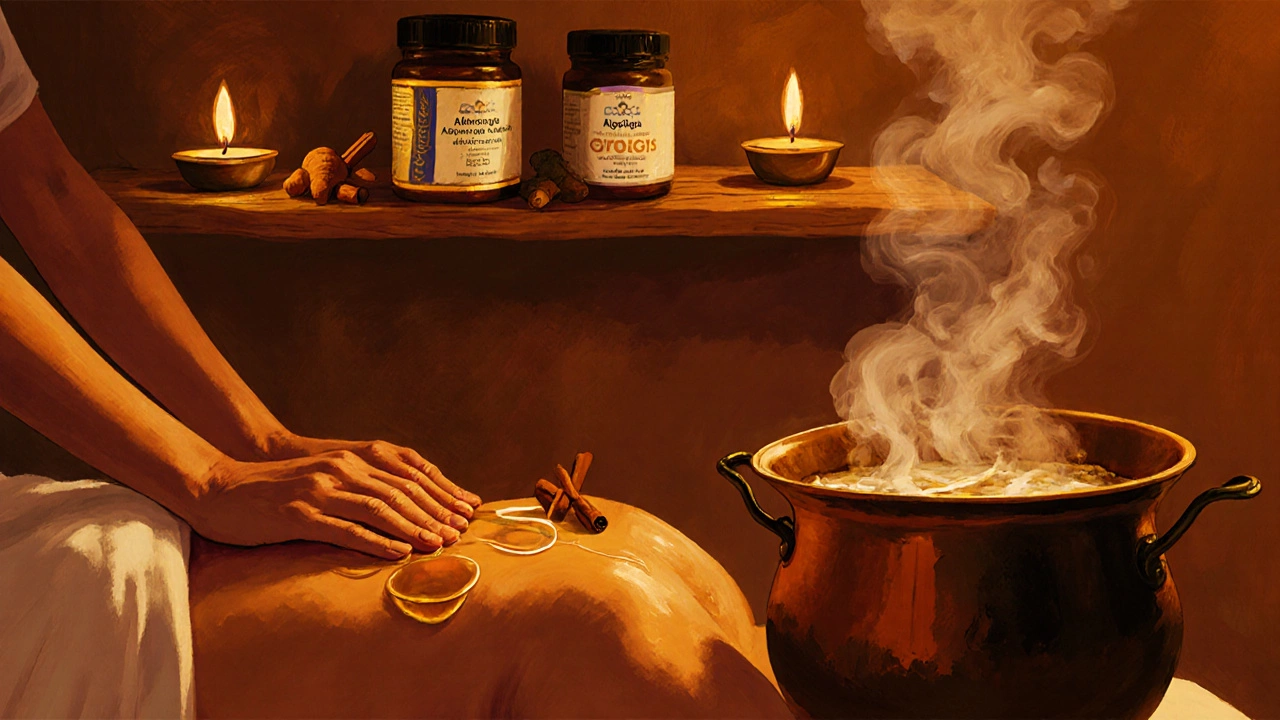Ayurveda Healing Time Calculator
Personalized Healing Timeline Estimator
Your Estimated Healing Timeline
If you’ve ever wondered Ayurveda healing time, you’re not alone. Ayurveda is a traditional Indian system of medicine that balances body, mind, and spirit through diet, herbs, and lifestyle often prompts the question, “When will I feel the difference?” The answer isn’t one‑size‑fits‑all, but understanding the core principles helps you set realistic expectations.
Key Takeaways
- Short‑term changes (energy, digestion) can appear in 1‑3 weeks.
- Deep detox or Panchakarma cycles typically need 2‑6 weeks.
- Full constitutional balance may take 3‑12 months, depending on your Dosha profile and lifestyle.
- Consistency, proper diet, and seasoned Ayurvedic practitioner guidance dramatically shorten the timeline.
- Patience pays off - rushed shortcuts often delay or reverse benefits.
Understanding the Core: Doshas and Their Role in Healing Speed
Ayurveda revolves around the three Dosha principles: Vata, Pitta, and Kapha. Each person has a unique combination, and the degree of imbalance dictates how fast the body responds to treatment.
For example, a dominant Vata person typically experiences quick shifts in digestion and mental clarity, so they may notice benefits within days. In contrast, a Kapha dominance often means slower metabolism, so deeper changes can take weeks or months.
What Influences the Timeline?
Several variables shape the speed of results:
- Severity of imbalance: Mild digestive upset resolves faster than chronic joint inflammation.
- Chosen modality: Simple herbal supplements act quicker than a full‑body Panchakarma protocol.
- Lifestyle adherence: Skipping the prescribed diet or sleep schedule stalls progress.
- Age and metabolism: Younger bodies generally detoxify faster.
- Quality of herbs: Fresh, ethically sourced ingredients contain higher active compounds.

Typical Onset Times for Common Ayurvedic Approaches
| Treatment | Primary Goal | Usual Onset |
|---|---|---|
| Herbal supplement (e.g., Ashwagandha) | Adaptogenic support, stress reduction | 1-3 weeks |
| Panchakarma (detox program) | Deep cleansing, toxin removal | 2-6 weeks (including post‑therapy diet) |
| Dietary & lifestyle overhaul (Satvic diet, yoga) | Long‑term balance, weight management | 4-12 weeks for steady trends |
| Specific herb blends (e.g., Turmeric + Triphala) | Anti‑inflammatory, digestive aid | 2-4 weeks |
The numbers above are averages from clinical observations in Indian Ayurvedic institutes and patient logs from Bangalore clinics (2023‑2024). Individual results can vary.
How to Speed Up the Process
While you can’t force the body to heal instantly, a few practical steps can shave weeks off the timeline:
- Personalized Dosha assessment: Get a professional reading to know which foods, spices, and exercises suit you best.
- Start with high‑bioavailability herbs: Ashwagandha extracts (KSM‑66) absorb faster than raw powder.
- Follow the Satvic diet: Emphasize fresh vegetables, whole grains, and ghee; avoid processed sugars that aggravate Pitta.
- Maintain a regular sleep‑wake cycle: Ayurvedic texts link sunrise meditation to quicker detox.
- Stay hydrated with warm water: Helps mobilize toxins that the liver and lymphatic system release during Panchakarma.
Common Mistakes That Delay Results
Even enthusiastic beginners can stall progress inadvertently. Watch out for these pitfalls:
- Skipping the preparatory diet before a Panchakarma cleanse - the body won’t release toxins efficiently.
- Mixing all three dosha‑balancing herbs at once - can cause confusion in the system.
- Relying on over‑processed “Ayurvedic” supplements that contain fillers; quality matters more than brand name.
- Expecting overnight miracles - Ayurveda works with the body’s natural rhythms, not like a synthetic drug.
- Neglecting the mental component; stress heightens Vata, undoing physical gains.

Real‑World Case Snapshots
Case 1 - Stress‑related insomnia: A 32‑year‑old software engineer with dominant Vata took a 12‑week Ashwagandha protocol (300mg KSM‑66 twice daily) plus evening Abhyanga oil massage. Sleep quality improved within 10 days, and full circadian reset took 8 weeks.
Case 2 - Chronic knee inflammation (Kapha‑dominant): A 58‑year‑old retired teacher underwent a 3‑week Panchakarma followed by a Kapha‑balancing diet and daily Turmeric‑Triphala tea. Pain scores dropped 40% after the first week of detox and reached 80% reduction by week10.
Case 3 - Type‑2 diabetes management: A 45‑year‑old man with mixed Vata‑Kapha started a low‑glycemic Satvic diet, daily Triphala (1g), and regular yoga. HbA1c decreased from 8.2% to 6.9% over 4 months, showing steady metabolic improvement.
Quick Checklist: Managing Your Expectations
- Identify your primary Dosha imbalance.
- Choose a focused modality (herb, Panchakarma, diet) rather than mixing everything.
- Commit to at least 3weeks before judging effectiveness.
- Track changes daily - sleep, digestion, mood, and joint comfort.
- Consult a qualified Ayurvedic practitioner every 2-4 weeks for adjustments.
Frequently Asked Questions
How soon can I feel the effects of Ashwagandha?
Most people report reduced stress and better sleep within 7‑10 days of a consistent 300‑mg KSM‑66 dose, but full hormonal balance may take 4‑6 weeks.
Is a 3‑day Panchakarma enough?
A short 3‑day cleanse can jump‑start toxin release, but sustained results usually require a 7‑14‑day program followed by a post‑therapy diet for at least a month.
Can I combine Turmeric with other herbs?
Yes. Turmeric pairs well with black pepper (piperine) to boost absorption, and with Triphala for digestive support. Avoid mixing it with strong diuretics unless advised.
Do I need to stop all medications during a Panchakarma?
Never stop prescribed medicines without a doctor’s approval. Ayurvedic detox can be coordinated with allopathic treatments, but a practitioner should adjust dosages.
What’s the best way to track progress?
Keep a simple journal noting sleep quality, appetite, bowel movements, energy levels, and any pain. A weekly photo or measurement helps visualize changes.
In short, Ayurveda doesn’t promise an instant miracle, but with the right dosha‑focused plan, quality herbs like Turmeric or Triphala, and disciplined lifestyle, most people see measurable benefits within weeks and deeper transformation over months. Patience, consistency, and expert guidance are the true accelerators.
